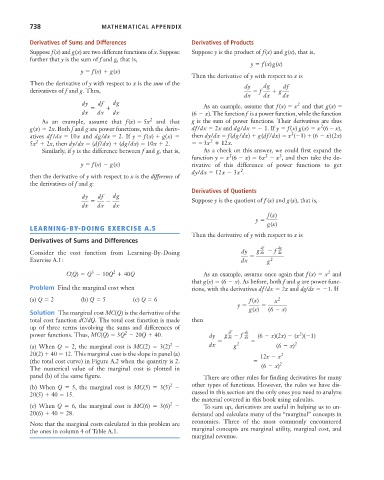Page 764 - Microeconomics, Fourth Edition
P. 764
BMappAMathematicalAppendix.qxd 8/17/10 1:10 AM Page 738
738 MATHEMATICAL APPENDIX
Derivatives of Sums and Differences Derivatives of Products
Suppose f(x) and g(x) are two different functions of x. Suppose Suppose y is the product of f (x) and g(x), that is,
further that y is the sum of f and g, that is,
y f (x)g(x)
y f (x) g(x)
Then the derivative of y with respect to x is
Then the derivative of y with respect to x is the sum of the dy dg df
derivatives of f and g. Thus, f g
dx dx dx
dy df dg 2
As an example, assume that f (x) x and that g(x)
dx dx dx (6 x) . The function f is a power function, while the function
As an example, assume that f (x) 5x 2 and that g is the sum of power functions. Their derivatives are thus
2
g(x) 2x . Both f and g are power functions, with the deriv- df/dx 2x and dg/dx 1. If y f (x) g(x) x (6 x) ,
2
atives df /dx 10x and dg/dx 2 . If y f (x) g(x) then dy/dx f (dg/dx) g(df /dx) x ( 1) (6 x) (2x)
2
2
5x 2x, then dy/dx (df/dx) (dg/dx) 10x 2 . 3x 12x .
Similarly, if y is the difference between f and g, that is, As a check on this answer, we could first expand the
2
2
function y x (6 x) 6x x 3 , and then take the de-
y f (x) g(x) rivative of this difference of power functions to get
dy/dx 12x 3x 2 .
then the derivative of y with respect to x is the difference of
the derivatives of f and g:
Derivatives of Quotients
dy df dg
Suppose y is the quotient of f (x) and g (x), that is,
dx dx dx
f (x)
y
LEARNING-BY-DOING EXERCISE A.5 g(x)
Then the derivative of y with respect to x is
Derivatives of Sums and Differences
dg
df
Consider the cost function from Learning-By-Doing dy g f
dx
dx
Exercise A.1: dx g 2
2
2
3
C(Q) Q 10Q 40Q As an example, assume once again that f (x) x and
that g(x) (6 x). As before, both f and g are power func-
Problem Find the marginal cost when tions, with the derivatives df /dx 2x and dg/dx 1. If
(a) Q 2 (b) Q 5 (c) Q 6 f (x) x 2
y
Solution The marginal cost MC(Q) is the derivative of the g(x) (6 x)
total cost function dC/dQ. The total cost function is made then
up of three terms involving the sums and differences of
df
2
power functions. Thus, MC(Q) 3Q 20Q 40. dy g f dg (6 x)(2x) (x )( 1)
2
dx
dx
2 2
2
(a) When Q 2, the marginal cost is MC(2) 3(2) dx g (6 x)
20(2) 40 12. This marginal cost is the slope in panel (a) 12x x 2
(the total cost curve) in Figure A.2 when the quantity is 2. 2
The numerical value of the marginal cost is plotted in (6 x)
panel (b) of the same figure. There are other rules for finding derivatives for many
2
(b) When Q 5, the marginal cost is MC(5) 3(5) other types of functions. However, the rules we have dis-
20(5) 40 15. cussed in this section are the only ones you need to analyze
the material covered in this book using calculus.
2
(c) When Q 6, the marginal cost is MC(6) 3(6) To sum up, derivatives are useful in helping us to un-
20(6) 40 28. derstand and calculate many of the “marginal” concepts in
economics. Three of the most commonly encountered
Note that the marginal costs calculated in this problem are
the ones in column 4 of Table A.1. marginal concepts are marginal utility, marginal cost, and
marginal revenue.

